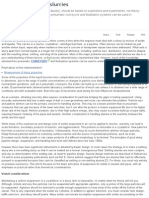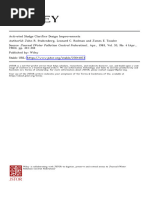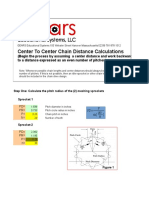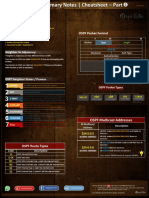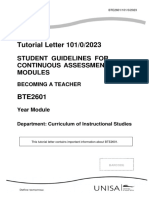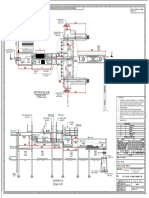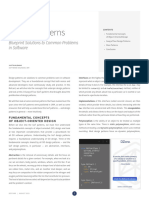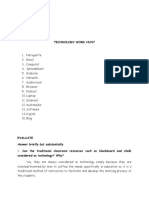WR WQ Pub Design Criteria Ch12
WR WQ Pub Design Criteria Ch12
Uploaded by
AshokCopyright:
Available Formats
WR WQ Pub Design Criteria Ch12
WR WQ Pub Design Criteria Ch12
Uploaded by
AshokOriginal Description:
Original Title
Copyright
Available Formats
Share this document
Did you find this document useful?
Is this content inappropriate?
Copyright:
Available Formats
WR WQ Pub Design Criteria Ch12
WR WQ Pub Design Criteria Ch12
Uploaded by
AshokCopyright:
Available Formats
CHAPTER 12
Sludge Processing and Disposal
12.1 General
12.1.1 Definition
12.1.2 Total Systems Approach To Design
12.1.3 Recycle Streams
12.1.4 Multiple Units
12.1.5 Sludge Pumps
12.1.6 Sludge Piping
12.2 Sludge Production
12.3 Thickening
12.3.1 General
12.3.2 Gravity Thickeners
12.3.3 Flotation Thickeners
12.3.4 Centrifugal Thickeners
12.3.5 Other Thickeners
12.4 Conditioning
12.4.1 General
12.4.2 Chemical
12.5 Digestion
12.5.1 Anaerobic Digestion
12.5.2 Aerobic Sludge Digestion
12.6 Composting
12.7 Sludge Dewatering
12.7.1 General
12.7.2 Sludge Drying Beds
12.7.3 Mechanical Dewatering
12.8 Sludge Storage Lagoons
12.9 Sludge Disposal
January 2016 12-1 Design Criteria Ch. 12
SLUDGE PROCESSING AND DISPOSAL
12.1 General
12.1.1 Definition
Sludge is a broad term used to describe the various aqueous suspensions of solids
encountered during treatment of sewage. The nature and concentration of the
solids control the processing characteristics of the sludge. Grit screenings and
scum are not normally considered as sludge and therefore are not discussed in this
section.
12.1.2 Total Systems Approach to Design
The most frequently encountered problem in wastewater treatment plant design is
the tendancy to optimize a given subsystem, such as sludge dewatering, without
considering the side effects of this optimization on the overall plant operation and
treatment costs.
Sludge handling processes can be classified as thickening, conditioning,
stabilization, dewatering, and disposal. Numerous process alternatives exist
within each of these categories. Each unit process should be evaluated as part of
the total system, keeping in mind that the objective is to use that group of
processes that provides the most cost-effective method of sludge disposal.
The analysis should include a materials balance to identify the amounts of
material which enter, leave, accumulate, or are depleted in the given process and
the system as a whole. Energy requirements should also be provided to aid in
determining capital and operating costs of the total system.
12.1.3 Recycle Streams
Recycle streams from the process alternatives, including thickener overflow,
centrate, filtrate, and supernatant, should be returned to the sewage treatment
process at appropriate points to maintain effluent quality within the limits
established. Volume and strength of each recycle stream should be considered in
the plant design. Sidestream treatment should be provided if the load is not
included in the plant design or if the side stream will upset the treatment process.
Equalization of side streams should be considered to reduce instantaneous loading
on the treatment process.
12.1.4 Multiple Units
Multiple units and/or storage facilities should be provided so that individual units
may be taken out of service without unduly interrupting plant operation.
January 2016 12-2 Design Criteria Ch. 12
12.1.5 Sludge Pumps
12.1.5.1 Capacity
Pump capacities should be adequate to maintain pipeline velocities of 3
feet per second. Provisions for varying pump capacity are desirable.
12.1.5.2 Duplicate Units
Duplicate units shall be provided where failure of one unit would
seriously hamper plant operation.
12.1.5.3 Type
Plunger pumps, progressing cavity pumps, or other types of pumps with
demonstrated solids handling capability should be provided for handling
raw sludge.
12.1.5.4 Minimum Head
A minimum positive head of 24 inches (or the manufacturer's
recommendation) should be provided at the suction side of
centrifugal-type pumps and is desirable for all types of sludge pumps.
Maximum suction lifts should not exceed 10 feet (or the manufacturer's
recommendation) for plunger pumps.
12.1.5.5 Sampling Facilities
Unless sludge sampling facilities are otherwise provided, quick-closing
sampling valves should be installed at the sludge pumps. The size of
valve and piping should be at least 1-1/2 inches.
12.1.6 Sludge Piping
12.1.6.1 Size and Head
Sludge withdrawal piping shall have a minimum diameter of 8 inches for
gravity withdrawal and 6 inches for pump suction and discharge lines.
Where withdrawal is by gravity, the available head on the discharge pipe
should be at least 2 feet and preferably more, with provisions to
backflush the line.
January 2016 12-3 Design Criteria Ch. 12
12.1.6.2 Slope
Gravity piping shall be laid on uniform grade and alignment. Slope on
gravity discharge piping should not be less than 3 percent.
12.1.6.3 Cleaning
Provision should be made for draining and flushing suction and discharge
lines. Where sludge pumps are available, piping should be such that
suction lines can be backflushed with pump discharge or rodded.
Glass-lined or equivalent pipe should be considered for raw sludge piping
and scum lines.
12.1.6.4 Corrosion Resistance
Special consideration shall be given to the corrosion resistance and
continuing stability of pipes and supports located inside digestion tanks.
12.2 Sludge Production
The sludge production rates listed in the literature have often been shown to be
underestimated. The sludge production rates (SPR) listed below in Table 12-1
have been determined from various studies and provide a more realistic basis for
designing solids handling facilities. These values shall be used for design unless
other acceptable data is submitted.
Table 12-1
Sludge Production Rates
(lb sludge)
Type of Treatment SPR ( lb BOD removed)
Conventional Activated Sludge 0.85
Extended Aeration 0.75
Contact Stabilization 1.00
Other Activated Sludge 0.85
Trickling Filter 0.75
Roughing Filters 1.00
January 2016 12-4 Design Criteria Ch. 12
12.3 Thickening
12.3.1 General
The cost-effectiveness of sludge thickening should be considered prior to
treatment and/or disposal.
12.3.1.1 Capacity
Thickener design should provide adequate capacity to meet peak
demands.
12.3.1.2 Septicity
Thickener design should provide means to prevent septicity during the
thickening process. Odor consideration should be considered.
12.3.1.3 Continuous Return
Thickeners should be provided with a means of continuous return of
supernatant for treatment. Provisions for side-stream treatment of
supernatant may be required.
12.3.1.4 Chemical Addition
Consideration should be given to the use of chemicals or polymer to
improve solids capture in the thickening process. This will not normally
increase the solids level of the thickened sludge.
12.3.2 Gravity Thickeners
12.3.2.1 Stirring and skimming
Mechanical thickeners should employ pickets on rake arms for
continuous gentle stirring of the sludge. Skimmers should be considered
for use with biological sludges.
12.3.2.2 Depth and Freeboard
Tank depth shall be sufficient so that solids will be retained for a period
of time needed to thicken the sludge to the required concentration and to
provide storage for fluctuations in solids loading rates.
The thickener should be operated to avoid denitrification. At least two
feet of freeboard shall be provided above the maximum water level.
January 2016 12-5 Design Criteria Ch. 12
12.3.2.3 Continuous Thickening
Variable-speed sludge draw-off pumps may be provided so that
thickening can be continuous, or an adjustable on-off time clock control
for pulse withdrawal may be used with constant-speed pumps to
improve control over the thickening.
12.3.2.4 Solids and Surface Loading Rates
The engineer shall provide the design basis and calculations for the solids
and surface loading rates and the support calculations upon request.
Thickener solids loading rates vary with the type of sludge. Some typical
solids loading rates are given below in Table 12-2. These values shall be
used for design unless other acceptable data are submitted. For loading
rates of other type sludges, refer to Table 5.2 of the EPA Process Design
Manual-Sludge Treatment and Disposal.
Table 12-2
Solids Loading Rate
Type of Sludge (lb/day/sq ft)
Primary 20-30
Activated sludge 5-6
Trickling filter 8-10
Primary and activated combined 6-10
Primary and trickling filter combined 10-12
Surface loading rates of 400 gallons per day per square foot (gpd/sq ft) or
less will normally result in septic conditions. To prevent septic conditions,
surface overflow rates should be maintained between 500 and 800 gpd/sq
ft. For very thin mixtures or WAS only, hydraulic loading rates of
100-200 gpd/sq ft are appropriate. An oxygen-rich water source, such as
secondary effluent, shall be available as a supplemental flow to the
thickener to achieve the necessary overflow rates.
The diameter of a gravity thickener should not exceed 80 feet.
January 2016 12-6 Design Criteria Ch. 12
12.3.2.5 Bottom Slope
Bottom slopes shall be sufficient to keep the sludge moving toward the
center well with the aid of a rake. Generally, the slope should be greater
than conventional clarifiers. A floor slope of 2-3 inches per foot is
recommended.
12.3.3 Flotation Thickeners
Flotation thickeners are normally used to concentrate waste activated sludge.
12.3.3.1 Air-Charged Water
The thickener underflow is generally used as a source of water for the
air-charging units, although primary tank effluent or plant effluent may
also be used.
12.3.3.2 Design Sizing
The engineer shall provide the design basis for sizing the units and for the
support calculation. Design sizing should be based on rational
calculations, including: total pounds of waste sludge anticipated, design
solids and hydraulic loading of the unit, operating cycle in hours per day
per week, removal efficiency, and quantity and type of chemical aids
required. Flotation thickeners are normally sized by solids surface
loadings.
Typical design loadings range from 1.0 to 2.5 pounds per hour per square
foot. (See Table 12-3, for typical solids loading rates to produce a
minimum 4% solids concentration.)
12.3.3.3 Hydraulic Loading Rates
If polymers are used, hydraulic loading rates of 2.5 gpm/sq ft or less
should be used. The hydraulic loading rates shall be lower if polymers are
not used. Hydraulic loading rates shall be based on the total flow (influent
plus recycle). The design of any thickened sludge pump from DAF units
should be conservative. Frequently, polymer conditioned sludge will
result in a solids concentration greater than 4%. Pumps shall be capable of
handling a sludge of at least 5% thickness.
January 2016 12-7 Design Criteria Ch. 12
TABLE 12-3
TYPICAL DAF THICKENER SOLIDS LOADING RATES NECESSARY TO
PRODUCE A MINIMUM 4 PERCENT SOLIDS CONCENTRATION
Solids loading rate, lb/sq ft/hr
Type of sludge No chemical addition Optimum chemical addition
Primary only 0.83 - 1.25 up to 2.5
Waste activated
sludge (WAS)
Air 0.42 up to 2.0
Oxygen 0.6 - 0.8 up to 2.2
Trickling filter 0.6 - 0.8 up to 2.0
Primary + WAS (air) 0.6 - 1.25 up to 2.0
Primary + trickling
filter 0.83 - 1.25 up to 2.5
12.3.4 Centrifugal Thickeners
12.3.4.1 Pretreatment
Any pretreatment required is in addition of that required for the main
wastewater stream. For example, separate and independent grit removal
may be needed for the centrifuge feed stream.
Disc nozzle centrifuges require pretreatment of the feed stream. Both
screening and grit removal are required to reduce operation and
maintenance requirements. Approximately 11% of the feed stream will be
rejected in pretreatment, consideration should be given to the treatment of
this flow. It is usually routed to the primary clarifier.
Basket centrifuges do not require pretreatment and are recommended in
small plants (1.0-2.0 MGD) without primary clarification and grit
removal.
Solid bowl decanter centrifuges require grit removal in the feed stream
and are a potentially high maintenance item.
January 2016 12-8 Design Criteria Ch. 12
12.3.4.2 Chemical Coagulants
Provisions for the addition of coagulants to the sludge should be
considered for improving dewatering and solids capture.
12.3.4.3 Design Data
The engineer shall provide the design basis for loading rates and support
calculations. Both hydraulic and solids loading rate limitations should be
addressed.
12.3.5 Other Thickeners
Other thickner designs will be evaluated on a case-by-case basis. Pilot
plant data shall be provided by the design engineer upon request.
12.4 Conditioning
12.4.1 General
Pretreatment of the sludge by chemical or thermal conditioning should be
investigated to improve the thickening, dewatering, and/or stabilization
characteristics of the sludge.
The effects of conditioning on downstream processes and subsequent side-stream
treatment should be evaluated. Thermal conditioning will concentrate the BOD
level of the side stream. Its treatment must be considered in calculating organic
loadings of other units.
12.4.2 Chemical
Type of chemical, location of injection, and method of mixing should be carefully
considered to ensure obtaining anticipated results. Pilot testing is often necessary
to determine the best conditioning system for a given sludge.
12.5 Digestion
12.5.1 Anaerobic Digestion
12.5.1.1 General
January 2016 12-9 Design Criteria Ch. 12
a. Operability
Anaerobic digestion is a feasible stabilizing method for wastewater
sludges that have low concentrations of toxins and a volatile solids content
above 50%. It should not be used where wide variations in sludge
quantity and quality are common. Anaerobic digestion is a complex
process requiring close operator control. The process is very susceptible
to upsets as the microorganisms involved are extremely sensitive to
changes of their environment. Frequent monitoring of the following
parameters is required:
(i) pH (6.4 - 7.5 recommended)
(ii) volatile acids/alkalinity ratio (always 0.5 or greater)
(iii) toxics (volatile acids, heavy metals, light metal cations, oxygen,
sulfides, and ammonia)
(iv) temperature (within 1 F of design temperature)
(v) recycle streams (BOD, SS, NH3, phenols)
The importance of avoiding digester upsets cannot be overlooked. The
methane-producer bacteria have a very slow growth rate and it will take
two weeks or more to resume normal digester performance.
b. Multiple Units
Multiple units should be provided. Staged digestion design may be used,
provided the units can be used in parallel as well as in series. Where
multiple units are not provided, a lagoon or storage tanks should be
provided for emergency use so that digestion tanks may be taken out of
service without unduly interrupting plant operation. Means of returning
sludge from the secondary digester unit to the primary digester should be
provided. In large treatment plants where digesters are provided, separate
digestion of primary sludges should be considered.
c. Depth
The proportion of depth to diameter should provide for the formation of a
supernatant liquor with a minimum depth of 6 feet. Sidewall depth is
generally about one-half the diameter of the digester for diameters up to
60 feet, and decreases to about one-third the diameter for diameters
approaching 100 feet.
January 2016 12-10 Design Criteria Ch. 12
d. Maintenance Provisions
To facilitate emptying, cleaning, and maintenance, the following features
are required:
(i) Slope
The tank bottom shall slope to drain toward the withdrawal pipe. A slope
of between 1 inch per foot and 3 inches per foot is recommended.
(ii) Access Manholes
At least two access manholes should be provided in the top of the tank, in
addition to the gas dome. One opening should be large enough to permit
the insertion of mechanical equipment to remove scum, grit, and sand. A
separate side wall manhole should be provided at ground level.
(iii) Safety
Nonsparking tools, rubber-soled shoes, safety harness, gas detectors for
flammable and toxic gasses and the hose type or self-contained type
breathing apparatus shall be provided.
e. Pre-thickening of sludge may be advantageous, but the solids content
shall be less than 8% to ease mixing problems.
12.5.1.2 Sludge Inlets and Outlets
Multiple sludge inlets and draw-offs and multiple recirculation suction and
discharge points should be provided to facilitate flexible operation and
effective mixing of the digester contents, unless adequate mixing facilities
are provided within the digester. One inlet should discharge above the
liquid level and be located at approximately the center of the tank to assist
in scum breakup. Raw sludge inlet points should be located to minimize
short-circuiting to the supernatant drawoff.
12.5.1.3 Tank Capacity
a. General
Two cultures of bacteria are primarily involved in anaerobic digestion:
acid formers and methane formers. Capacity of the digester tank shall be
based on the growth rate of the methane-formers, as they have extremely
slow growth rates.
January 2016 12-11 Design Criteria Ch. 12
b. Solids Basis
Where the composition of the sewage has been established, tank capacity
should be computed from the volume and character of sludge to be
digested. The total digestion tank capacity should be determined by
rational calculations based upon factors such as volume of sludge added,
its percent solids and character, volatile solids loading, temperature to be
maintained in the digesters, and the degree or extent of mixing to be
obtained. These detailed calculations shall be submitted to justify the
basis of design.
Where composition of the sewage has not been established, the minimum
combined digestion tank capacity outlined below shall be provided. Such
requirements assume that the raw sludge is derived from ordinary
domestic wastewater, a digestion temperature is maintained in the range of
85 to 100 F, there is 40 to 50 percent volatile matter in the digested
sludge, and that the digested sludge will be removed frequently from the
process.
(i) Completely Mixed Systems
For heated digestion systems providing for intimate and effective mixing
of the digester designed for a constant feed loading rate of 150 to 400
pounds 1,000 cubic feet of volume per day in the active digesting unit.
The design average detention time in completely mixed systems shall have
sufficient mixing capacity to provide for complete digester turnover every
30 minutes.
(ii) Moderately Mixed Systems
For digestion systems where mixing is accomplished only by circulating
external
heat exchanger, the system may be loaded up to 40 pounds of volatile
solids per 1,000 cubic feet of volume per day in the active digestion units.
This loading may be modified upward or downward, depending upon the
degree of mixing provided. Where mixing is accomplished by other
methods, loading rates will be determined on the basis of information
furnished by the design engineer.
January 2016 12-12 Design Criteria Ch. 12
c. Population Basis
Where solids data are not available, the following unit capacities shown in
Table 12-4 for conventional, heated tanks shall be used for plants treating
domestic sewage.
The capacities should be increased by allowing for the suspended solids
population equivalent of any industrial wastes in the sewage. The
capacities stated apply where digested sludge is dewatered on sand drying
beds and may be reduced if the sludge is dewatered mechanically or
otherwise frequently withdrawn.
Table 12-4
Cubic Feet Per Capita
Moderately Completely
Mixed Mixed
Type of Plant Systems Systems
Primary 2 to 3 1.3
Primary and
Trickling Filter 4 to 5 2.7 to 3.3
Primary and
Activated Sludge 4 to 6 2.7 to 4
For small installations (population 5,000 or less) the larger values should
be used.
12.5.1.4 Gas Collection System
a. General
All portions of the gas system, including the space above the tank liquor,
storage facilities, and piping shall be so designed that under all normal
operating conditions, including sludge withdrawal, the gas will be
maintained under positive pressure. All enclosed areas where any gas
leakage might occur shall be adequately ventilated.
b. Safety Equipment
All necessary safety facilities shall be included where gas is produced.
Pressure and vacuum relief valves and flame traps, together with
automatic safety shutoff valves, are essential. Water-seal equipment shall
not be installed on gas piping.
January 2016 12-13 Design Criteria Ch. 12
c. Gas Piping and Condensate
Gas piping shall be of adequate diameter and shall slope to condensation
traps at low points.
The use of float-controlled condensate traps is not permitted.
Condensation traps shall be placed in accessible locations for daily
servicing and draining. Cast iron, ductile iron, and/or stainless steel piping
should be used.
d. Electrical Fixtures and Equipment
Electrical fixtures and equipment in enclosed places where gas may
accumulate shall comply with the National Board of Fire Underwriters'
specifications for hazardous conditions. Explosion-proof electrical
equipment shall be provided in sludge-digestion tank galleries containing
digested sludge piping or gas piping and shall be provided in any other
hazardous location where gas or digested sludge leakage is possible.
e. Waste Gas
Waste gas burners shall be readily accessible and should be located at least
50 feet away from any plant structure, if placed near ground level, or may
be located on the roof of the control building if sufficiently removed from
the tank. Waste gas burners shall not be located on top of the digester.
The waste gas burner should be sized and designed to ensure complete
combustion to eliminate odors.
f. Ventilation and Cover
Any underground enclosures connecting with digestion tanks or
containing sludge or gas piping or equipment shall be provided with
forced ventilation. Tightly fitting, self-closing doors shall be provided at
connecting passageways and tunnels to minimize the spread of gas. A
floating cover should be provided instead of a fixed cover for increased
operational flexibility and safety.
g. Metering
Gas meters with bypasses should be provided to meter total gas production
and utilization.
January 2016 12-14 Design Criteria Ch. 12
h. Pressure Indication
Gas piping lines for anaerobic digesters should be equipped with
closed-type pressure indicating gauges. These gauges should read directly
in inches of water. Normally, three gauges should be provided, one to
measure the main line pressure, a second to measure the pressure upstream
of gas-utilization equipment, and the third to measure pressure to
wasteburners.
Gas-tight shutoff and vent cocks shall be provided. The vent piping shall
be extended outside the building, and the opening shall be screened to
prevent entrance by insects and turned downward to prevent entrance of
rainwater. All piping shall be protected with safety equipment.
i. Gas Utilization Equipment
Gas-burning boilers, engines, and other gas utilization equipment should
be located at or above ground level in well-ventilated rooms. Gas lines to
these units shall be provided with suitable flame traps.
12.5.1.5 Heating
a. Insulation
Digestion tanks should be constructed above the water table and should be
suitably insulated to minimize heat loss.
b. Heating Facilities
Sludge may be heated by circulating the sludge through external heaters or
by units located inside the digestion tank.
(i) External Heating
Piping should be designed to provide for the preheating of feed sludge
before introduction to the digesters. Provisions should be made in the
layout of the piping and valving to facilitate cleaning of these lines.
Heat exchanger sludge piping should be sized for heat transfer
requirements.
January 2016 12-15 Design Criteria Ch. 12
(ii) Internal Coils
Hot water coils for heating digestion tanks should be at least 2 inches in
diameter and the coils, support brackets, and all fastenings should be of
corrosion-resistant material. The use of dissimilar metals should be
avoided to minimize galvanic action. The high point in the coils should be
vented to avoid air lock.
(iii) Other Methods
Other types of heating facilities will be considered on their own merits.
c. Heating Capacity
Sufficient heating capacity shall be provided to consistently maintain the
digesting sludge temperature to within 1F (0.6C) of the design
temperature. An alternate source of fuel should be available and the boiler
or other heat source should be capable of using the alternate fuel if
digester gas is the primary fuel. Thermal shocks shall be avoided. Sludge
storage may be required to accomplish this.
d. Hot Water Internal Heating Controls
(i) Mixing Valves
A suitable automatic mixing valve should be provided to temper the boiler
water with return water so that the inlet water to the heat jacket or coils
can be held to below a temperature (130 to 150F) at which sludge caking
will be accentuated. Manual control should also be provided by suitable
bypass valves.
(ii) Boiler Controls
The boiler should be provided with suitable automatic controls to maintain
the boiler temperature at approximately 180F to minimize corrosion and
to shut off the main fuel supply in the event of pilot burner or electrical
failure, low boiler water level, or excessive temperature.
(iii) Thermometers
Thermometers shall be provided to show temperatures of the sludge, hot
water feed, hot water return, and boiler water.
January 2016 12-16 Design Criteria Ch. 12
12.5.1.6 Mixing
Facilities for mixing the digester contents shall be provided where
required for proper digestion by reason of loading rates, or other features
of the system.
12.5.1.7 Supernatant Withdrawal
a. Piping Size
Supernatant piping should not be less than 6 inches in diameter,
although 4-inch lines will be considered in special cases.
b. Withdrawal Arrangements
(i) Withdrawal Levels
Piping should be arranged so that withdrawal can be made from three
or more levels in the tank. A positive unvalved vented overflow shall
be provided.
(ii) Withdrawal Selection
On fixed-cover tanks the supernatant withdrawal level should
preferably be selected by means of interchangeable extensions at the
discharge end of the piping.
(iii) Supernatant Selector
If a moveable supernatant selector is provided, provision should be
made for at least one other draw-off level located in the supernatant
zone of the tank in addition to the unvalved emergency supernatant
draw-off pipe. High-pressure backwash facilities should be provided.
(iv) Sampling
Provisions shall be made for sampling at each supernatant draw-off
level. Sampling pipes should be at least 1-1/2 inches in diameter.
(v) Supernatant Handling
Problems such as shock organic loads, pH, and high ammonia levels
associated with digester supernatant shall be addressed in the plant
design. Recycle streams should be bled continuously back to the
treatment process.
January 2016 12-17 Design Criteria Ch. 12
12.5.2 Aerobic Sludge Digestion
12.5.2.1 Mixing and Aeration
Aerobic sludge digestion tanks shall be designed for effective mixing
and aeration. Minimum mixing requirements of 20 cubic feet per
minute per 1,000 cubic feet for air systems and 0.5 horsepower per 1,000
cubic feet for mechanical systems are recommended. Aeration
requirements may be more or less than the mixing requirements,
depending on system design and actual solids loading. Approximately
2.0 pounds of oxygen per pound volatile solids are needed for aeration.
If diffusers are used, types should be provided to minimize clogging and
designed to permit removal for inspection, maintenance, and
replacement without dewatering the tanks, if only one digester is
proposed.
12.5.2.2 Size and Number of Tanks
The size and number of aerobic sludge digestion tank or tanks should be
determined by rational calculations based upon such factors as volume
of sludge added, its percent solids and character, the degree of volatile
solids reduction required and the size of installation with appropriate
allowance for sludge and supernatant storage.
Generally, 40 to 50 percent volatile solids destruction is obtained during
aerobic digestion. To ensure a stabilized sludge which will not emit
odors, the volatile solids content should be less than 60 percent in the
digested sludge. Calculations shall be submitted upon request to justify
the basis of design. The following design parameter ranges should be
considered the minimum in designing aerobic digestion facilities.
a. Hydraulic Detention Time
Hydraulic detention time at 20C should be in the range of 15 to 25
days, depending upon the type of sludge being digested. Activated
sludge alone requires the lower detention time and a combination of
primary plus activated or trickling filter sludges requires the high
detention time. Detention times should be adjusted for operating
temperatures other than 20C.
January 2016 12-18 Design Criteria Ch. 12
b. Volatile Solids
The volatile solids loading shall be in the range of 0.1 to 0.2 pound of
volatile solids per cubic foot per day.
c. Dissolved Oxygen
Design dissolved oxygen concentration should be in the range of 1 to 2
mg/l. A minumum of 1.0 mg/l shall be maintained at all times.
d. Mixing Energy
Energy input requirements for mixing should be in the range of 0.5 to
1.5 horsepower per 1,000 cubic feet where mechanical aerators are used;
20 to 35 standard cubic feet of air per minute per 1,000 cubic feet of
aeration tank where diffused air mixing is used on activated sludge
alone; and greater than 60 cubic feet per minute per 1,000 cubic feet for
primary sludge alone and primary plus activated sludge.
e. Storage
Detention time should be increased for temperatures below 20C. If
sludge cannot be withdrawn during certain periods, additional storage
capacity should be provided. Plants smaller than 75,000 gpd should
have storage capacity of 2 cubic foot per population equivalent served.
12.5.2.3 Supernatant Separation
Facilities should be provided for separation or decantation of
supernatant. Provisions for sidestream treatment of supernatant should
be considered.
12.6 Composting
Composting operations will be considered on a case-by-case basis, provided that
the basis for design and a cost-effective analysis are submitted by the engineer.
12.7 Sludge Dewatering
12.7.1 General
Drainage from drying beds and centrate or filtrate from dewatering units should
be returned to the sewage treatment process at appropriate points preceding the
secondary process. The return flows shall be returned downstream of the influent
sample and/or flow measuring point and a means shall be provided to sample
return flows. These organic loads must be considered in plant design.
January 2016 12-19 Design Criteria Ch. 12
12.7.2 Sludge Drying Beds
12.7.2.1 Area
It is recommended that wastewater systems have a hybrid sludge
disposal method because of the seasonal downtime associated with
drying beds. The amount of rainfall
normal for our state makes the use of sludge drying beds insufficient at
times.
Consideration shall be given to the location of drying beds to avoid areas
where moisture in the air is higher than normal (i.e., adjacent to rivers
where morning fog is common).
In determining the area for sludge drying beds, consideration shall be
given to climatic conditions, the character and volume of the sludge to
be dewatered, type of bed used, and methods of ultimate sludge disposal.
Design calculations shall be submitted upon request to substantiate the
area used.
Drying bed design should be based on square feet per capita or pounds
of sludge solids per square foot per year.
Table 12-5 presents the range of values that should be used, these values
are for drying anaerobically digested sludges. Additional area is required
for wetter sludges such as those resulting from aerobic digestion;
therefore, use the higher number of the required range.
Table 12-5 DRYING BED DESIGN CRITERIA*
Open Beds Covered Beds
Per Capita Solids Per Capita
Type of Sludge (sq ft/capita) (lb/sq ft/yr) (sq ft/capita)
Primary 1.0 to 1.5 27.5 0.75 to 1.0
Attached Growth 1.25 to 1.75 22.0 1.0 to 1.25
Suspended Growth 2.50 15.0 2.00
*The design engineer should rely on his experience and the plant location.
These criteria are a minimum.
January 2016 12-20 Design Criteria Ch. 12
12.7.2.2. Percolation Type
a. Gravel
The lower course of gravel around the underdrains should be properly
graded to range in size from 1/4-inch to 1-inch and should be 12 inches
in depth, extending at least 6 inches above the top of the underdrains. It
is desirable to place this in 2 or more layers. The top layer of at least 3
inches should consist of gravel 1/8 inch to 1/4 inch in size. The gravel
shall be laid on an inpervious surface so that the filtrate will not escape
to the soil.
b. Sand
The top course shall consist of at least nine inches of sand with a
uniformity coefficient of less than 3.5. For trickling filter sludge, the
effective size of the sand shall be between 0.8 to 3.0 millimeter. For
waste activated sludge, the effective size of the sand shall be between
0.5 to 0.8 millimeter. For combinations, use the lower size range.
c. Underdrains
Underdrains should be clay pipe, concrete drain tile, or other underdrain
acceptable material and shall be at least 4 inches in diameter and sloped
not less than 1 percent to drain. Underdrains shall be spaced between 8
and 20 feet apart. The bottom of the bed shall slope towards the
underdrains. Consideration should be given to placing the underdrain in
a trench.
12.7.2.3 Impervious Types
Paved surface beds may be used if supporting data to justify such usage
are acceptable to the Department. The use of paved beds for aerobically
digested sludge is generally not recommended.
12.7.2.4 Walls
Walls should be watertight and extend 15 to 18 inches above the ground
surface. Outer walls should be curbed to prevent soil from washing onto
the beds.
12.7.2.5 Sludge Removal
Not less than two beds should be provided and they should be arranged to
facilitate sludge removal. Concrete truck tracks should be provided for all
January 2016 12-21 Design Criteria Ch. 12
percolation-type sludge beds with pairs of tracks for the beds on
appropriate centers. If truck access is by way of an opening in the drying
bed wall, the opening shall be designed so that no sludge will leak out
during the filling process.
12.7.2.6 Sludge Influent
The sludge pipe to the beds should terminate at least 12 inches above the
surface and be arranged so that it will drain. Concrete splash plates shall
be provided at sludge discharge points.
12.7.3 Mechanical Dewatering
12.7.3.1 Methods and Applicability
The methods used to dewater sludge may include use of one or more of
the following devices:
a. Rotary vacuum filters
b. Centrifuges, either solid bowl or basket type
c. Filter presses
d. Horizontal belt filters
e. Rotating gravity concentrators
f. Vacuum drying beds
g. Other "media type" drying beds
The technology and design of sludge dewatering devices are constantly
under development; therefore, each type should be given careful
consideration.
The applicability of a given method should be determined on a
case-by-case basis, with the specifics of any given situation being
carefully evaluated, preferably in pilot tests. The engineer shall justify the
method selected using pilot plant data or experience at a similar treatment
plant.
January 2016 12-22 Design Criteria Ch. 12
12.7.3.2 Considerations
Considerations in selection should include:
a. Type and amount of sludge
b. Variations in flow rate and solids concentration
c. Capacity of the equipment
d. Chemicals required for conditioning
e. Degree of dewatering required for disposal
f. Experience and qualifications of plant staff
g. Reliability
h. Operation and maintenance cost
i. Space requirements
12.7.3.3 Storage
Adequate storage shall be provided for all systems.
12.8 Sludge Storage Lagoons
Refer to Chapter 9, Ponds and Aerated Lagoons, for the requirements of sludge
storage lagoons.
12.9 Sludge Disposal
The ultimate disposal of sludge through various methods (i.e., landfilling, land
application) is subject to the regulations and/or guidelines of the Tennessee
Division of Water Pollution Control (DWPC). Approval by DWPC is required
prior to initiation of the selected disposal alternative.
January 2016 12-23 Design Criteria Ch. 12
You might also like
- CAP 15 - 3 Design of Water Resource Recovery Facilities, Sixth Edition Nitrogen-Removal-Sidestream-Process-DesignDocument4 pagesCAP 15 - 3 Design of Water Resource Recovery Facilities, Sixth Edition Nitrogen-Removal-Sidestream-Process-DesignNICOLAS SANCHEZ GOMEZNo ratings yet
- Volume 1 Solids ControlDocument232 pagesVolume 1 Solids ControlFranklin NarvaezNo ratings yet
- Field Applications PDFDocument64 pagesField Applications PDFYhonny PessoaNo ratings yet
- Amaco Solid Control Control Handbook Ch. 7Document5 pagesAmaco Solid Control Control Handbook Ch. 7Onur Deniz NarinNo ratings yet
- Potable Sedimentation TanksDocument5 pagesPotable Sedimentation Tanksupasana.b.1012No ratings yet
- Comparative Study of Crude Oil Dehydration EquipmentsDocument8 pagesComparative Study of Crude Oil Dehydration EquipmentsSterling GordianNo ratings yet
- WR WQ Pub Design Criteria Ch5Document10 pagesWR WQ Pub Design Criteria Ch5Teena AlawadNo ratings yet
- Chapter 80Document23 pagesChapter 80Stephen CanoNo ratings yet
- Chapter 1. IntroductionDocument2 pagesChapter 1. Introductionkaleem ullah janNo ratings yet
- Aws dp4-4Document11 pagesAws dp4-4Tan hun booNo ratings yet
- Centrifuge ThickeningDocument8 pagesCentrifuge ThickeningenviroashNo ratings yet
- USEPA Hydrodynamic SeparatorsDocument6 pagesUSEPA Hydrodynamic SeparatorsJp TreacyNo ratings yet
- Centrifuges: The Alternative Technology: Robert Klug and Nils SchwarzDocument8 pagesCentrifuges: The Alternative Technology: Robert Klug and Nils SchwarzEusebio Castillo MejiaNo ratings yet
- COMPREHENSIVE GUIDE Decanter Centrifuges 2021Document16 pagesCOMPREHENSIVE GUIDE Decanter Centrifuges 2021modshakNo ratings yet
- PEFG-1027 - Drum Sizing Design GuideDocument19 pagesPEFG-1027 - Drum Sizing Design GuideKochu dee100% (2)
- Vapour Disentrainment Trials Report: Richard Irons July 2009Document20 pagesVapour Disentrainment Trials Report: Richard Irons July 2009Largyla Torres MendesNo ratings yet
- Circular Deq 4: Montana Standards For Subsurface Wastewater Treatment SystemsDocument97 pagesCircular Deq 4: Montana Standards For Subsurface Wastewater Treatment SystemsParthiban GuruNo ratings yet
- General Hydrocyclone SPE 28815 Paper V1Document17 pagesGeneral Hydrocyclone SPE 28815 Paper V1bruelcharlesNo ratings yet
- Application of Multiphase Desander Technology To Oil and Gas ProductionDocument19 pagesApplication of Multiphase Desander Technology To Oil and Gas ProductionJose Rodrigo Salguero DuranNo ratings yet
- Applications of Multiphase Desander TechnologyDocument19 pagesApplications of Multiphase Desander TechnologyanisNo ratings yet
- Coulson& Richardson - Cap.10 Liquid-Liquid SeparationDocument7 pagesCoulson& Richardson - Cap.10 Liquid-Liquid SeparationayyatullhusnaaNo ratings yet
- (Compare Report) SAES-A-401Document42 pages(Compare Report) SAES-A-401kartik_harwani43870% (1)
- Mixer Skirt SupportDocument33 pagesMixer Skirt SupportRichard Nhyira Owusu-YeboahNo ratings yet
- Al Ain Sludge Dewatering ReportDocument15 pagesAl Ain Sludge Dewatering ReportHemant KaleNo ratings yet
- ASTM D7760 - Permeability of TDADocument6 pagesASTM D7760 - Permeability of TDASarangi M PNo ratings yet
- Saes G 006Document4 pagesSaes G 006AdnanAtifNo ratings yet
- Determining Sediment Pond Skimmer Flow Rate: Standard Practice ForDocument3 pagesDetermining Sediment Pond Skimmer Flow Rate: Standard Practice Forgt toniNo ratings yet
- Lamellar settling tanks - Degremont®Document5 pagesLamellar settling tanks - Degremont®Carlos TaglieroNo ratings yet
- TECHNICALDATADocument26 pagesTECHNICALDATARichard NwachukwuNo ratings yet
- MTPDF6 - Main Module PDF Preliminary and Primary TreatmentDocument32 pagesMTPDF6 - Main Module PDF Preliminary and Primary TreatmentEunnice PanaliganNo ratings yet
- Liquid Liquid Separation TechnologyDocument16 pagesLiquid Liquid Separation TechnologyMurrali Raj JeyagapalNo ratings yet
- Dow Guide Condensate PolishingDocument23 pagesDow Guide Condensate PolishingSayan Duangthong50% (2)
- Process Engineering - Avoid Trouble With Slurries - Chemical ProcessingDocument6 pagesProcess Engineering - Avoid Trouble With Slurries - Chemical Processingdenilson_cardosoNo ratings yet
- Plant Operation Series - A Practical Guide To Backwash Tuning For Reliable Sand Filter OperationDocument20 pagesPlant Operation Series - A Practical Guide To Backwash Tuning For Reliable Sand Filter OperationAlonso CoradoNo ratings yet
- 08) Coolers and CondensersDocument16 pages08) Coolers and CondensersShafei ZawahryNo ratings yet
- Dry Swales: Virginia DCR Stormwater Design Specification No. 10Document22 pagesDry Swales: Virginia DCR Stormwater Design Specification No. 10Hollman Yecid Cano SalazarNo ratings yet
- Deep Water Drilling Fluid Design ExampleDocument65 pagesDeep Water Drilling Fluid Design Examplecrown212No ratings yet
- Activated Sludge: January 2016 7-1 Design Criteria Ch. 7Document17 pagesActivated Sludge: January 2016 7-1 Design Criteria Ch. 7zamijakaNo ratings yet
- Ewatering: Eneral DvantagesDocument4 pagesEwatering: Eneral DvantagespkNo ratings yet
- Criteria DesandingDocument13 pagesCriteria Desandinglebrix100% (1)
- Applying Subsea FluidP Rocessing Technologies For Deepwater OperationsDocument10 pagesApplying Subsea FluidP Rocessing Technologies For Deepwater Operationsthelisabeth27No ratings yet
- Flows and Loads 43 PDFDocument6 pagesFlows and Loads 43 PDFrummaan17No ratings yet
- Sizing Criteria PDFDocument6 pagesSizing Criteria PDFAshwin DuhonarrainNo ratings yet
- Symrpl 15 KLD STPDocument15 pagesSymrpl 15 KLD STPDnyaneshwar Dattatraya Phadatare100% (5)
- Aerobic Sludge Digestion - Review Checklist: GeneralDocument4 pagesAerobic Sludge Digestion - Review Checklist: GeneralMagin Idelfonso TorreblancaNo ratings yet
- Activated Sludge Clarifier Design ImprovementsDocument9 pagesActivated Sludge Clarifier Design Improvements305773253No ratings yet
- Modular Sediment Barriers InstreamDocument6 pagesModular Sediment Barriers Instreamupasana.b.1012No ratings yet
- Tailings Management Multi Criteria Analysis Option Review For TSFsDocument12 pagesTailings Management Multi Criteria Analysis Option Review For TSFssamrkendallNo ratings yet
- Guidelines For Operation of Desilting Basins PDFDocument23 pagesGuidelines For Operation of Desilting Basins PDFRajni Sharma100% (2)
- Hydraulics of Sewage Treatment Plants Sec-6Document63 pagesHydraulics of Sewage Treatment Plants Sec-6hosny1987No ratings yet
- How Effective Is Current Solids Control Equipment For Drilling Fluids Weighted With Micron-Sized Weight Material?Document7 pagesHow Effective Is Current Solids Control Equipment For Drilling Fluids Weighted With Micron-Sized Weight Material?Jaime MartinezNo ratings yet
- Thickener Designand ControlDocument19 pagesThickener Designand ControlKiranNo ratings yet
- Ref N° 24 - PRODUCED WATER HANDLING - PHILOSOPHYDocument11 pagesRef N° 24 - PRODUCED WATER HANDLING - PHILOSOPHYlxz861020No ratings yet
- Consider Wet Scrubbers For Pollution Control: Environmental ManagementDocument5 pagesConsider Wet Scrubbers For Pollution Control: Environmental ManagementAnkur GavaiNo ratings yet
- Sediment Basin Design Fact SheetDocument43 pagesSediment Basin Design Fact SheetMuhammad Sya FiqNo ratings yet
- Nijhuis Water ConservationDocument2 pagesNijhuis Water ConservationDaniel PérezNo ratings yet
- Rainwater Harvesting From The RoofDocument153 pagesRainwater Harvesting From The RoofREBogart95% (20)
- Sewage Disposal Works: Their Design and ConstructionFrom EverandSewage Disposal Works: Their Design and ConstructionNo ratings yet
- Sprocket Blank Diameter Calculator (Version 02 - 09/09/2008) Author: Douglas AndersonDocument5 pagesSprocket Blank Diameter Calculator (Version 02 - 09/09/2008) Author: Douglas AndersonAshokNo ratings yet
- Motor Selection GuideDocument56 pagesMotor Selection GuideAshokNo ratings yet
- Spring Design: GD N PC yDocument2 pagesSpring Design: GD N PC yAshokNo ratings yet
- Center To Center Chain Distance CalculationsDocument4 pagesCenter To Center Chain Distance CalculationsAshokNo ratings yet
- Worksheet in Roller ChainDocument5 pagesWorksheet in Roller ChainAshokNo ratings yet
- Wrd-Ot-Clarifiers 445261 7Document99 pagesWrd-Ot-Clarifiers 445261 7AshokNo ratings yet
- Power (P) = T X Ω Torque (T) =F X R FORCE (F) = M X a =M X9.81: Let Us Consider 7Hp Motor For ShaftDocument3 pagesPower (P) = T X Ω Torque (T) =F X R FORCE (F) = M X a =M X9.81: Let Us Consider 7Hp Motor For ShaftAshokNo ratings yet
- Catalog C v5 PDFDocument80 pagesCatalog C v5 PDFAshokNo ratings yet
- Agitator Blade Ii: Ga Drawing For 4 KL, Vertical Mixing TankDocument1 pageAgitator Blade Ii: Ga Drawing For 4 KL, Vertical Mixing TankAshokNo ratings yet
- Sludge Drying BedDocument2 pagesSludge Drying BedAshok100% (1)
- Drying BedDocument1 pageDrying BedAshokNo ratings yet
- Dimple Jacket Development QTY-01 NOS.: General NotesDocument1 pageDimple Jacket Development QTY-01 NOS.: General NotesAshokNo ratings yet
- UNI TankDocument1 pageUNI TankAshokNo ratings yet
- Plastics Services OverviewDocument1 pagePlastics Services OverviewAshokNo ratings yet
- Dhruda CAE Simulation ServicesDocument1 pageDhruda CAE Simulation ServicesAshokNo ratings yet
- Uni Tank-Dimple Jacket DetailsDocument1 pageUni Tank-Dimple Jacket DetailsAshokNo ratings yet
- Red Hat Certification Remote Exams Frequently Asked QuestionsDocument5 pagesRed Hat Certification Remote Exams Frequently Asked Questionsvadym_kovalenko4166No ratings yet
- OSPF Part2 - Study Notes CheatSheet - (Waqas Karim) WK v2Document1 pageOSPF Part2 - Study Notes CheatSheet - (Waqas Karim) WK v2Sivaraman AlagappanNo ratings yet
- Bit LogicDocument20 pagesBit LogicTracktor7 TracktordesaNo ratings yet
- This Udyog Aadhaar Memorandum (UAM) Is Valid Till 31/12/2021Document1 pageThis Udyog Aadhaar Memorandum (UAM) Is Valid Till 31/12/2021RajatNo ratings yet
- RF Engineer Job Responsibilities Performed On LTE, 5GDocument2 pagesRF Engineer Job Responsibilities Performed On LTE, 5GBoby SharifNo ratings yet
- Tutorial Letter 101/0/2023: Student Guidelines For Continuous Assessment ModulesDocument20 pagesTutorial Letter 101/0/2023: Student Guidelines For Continuous Assessment ModulesELINAH MSIZANo ratings yet
- 5800 Russell, Wall PackDocument5 pages5800 Russell, Wall PackNaeemullah Khan MaharNo ratings yet
- 7-Advanced Features of HTML 1Document10 pages7-Advanced Features of HTML 1learnkid s100% (1)
- Amir' 'Dalya' 'Amir': Commands and StuffDocument1 pageAmir' 'Dalya' 'Amir': Commands and StuffPain KillersNo ratings yet
- ECEM - Analysis of Pin Jointed Plane Trusses - Method of JointsDocument15 pagesECEM - Analysis of Pin Jointed Plane Trusses - Method of JointsAnupEkbote100% (1)
- Efi System (1Nz Fe/2Nz Fe) : How To Proceed With TroubleshootingDocument5 pagesEfi System (1Nz Fe/2Nz Fe) : How To Proceed With TroubleshootingMortada AlsonniNo ratings yet
- 3 MLD PTU PUNJAB-ModelDocument1 page3 MLD PTU PUNJAB-ModelMohit ChauhanNo ratings yet
- InfyTQ Practice Problem - Day 23Document3 pagesInfyTQ Practice Problem - Day 23Shobhit TiwariNo ratings yet
- Micro Project: Shri H. H. J. B. PolytechnicDocument12 pagesMicro Project: Shri H. H. J. B. Polytechnicborse100% (1)
- Literature Review Establishment of NGO's in KenyaDocument7 pagesLiterature Review Establishment of NGO's in KenyaJunior GeofreyNo ratings yet
- Industrial Training Technical Report AT Ferryrich SDN BHDDocument11 pagesIndustrial Training Technical Report AT Ferryrich SDN BHDSITI NABILAH ABDULLAHNo ratings yet
- Microsoft Office Specialist (MOS) Overview: Click To Edit Master Title StyleDocument30 pagesMicrosoft Office Specialist (MOS) Overview: Click To Edit Master Title StyleMoon KimNo ratings yet
- Diagnosing and Troubleshooting Common System IssuesDocument22 pagesDiagnosing and Troubleshooting Common System IssuesAamir MalikNo ratings yet
- House DZ Refcard 008 Design Patterns 2023Document11 pagesHouse DZ Refcard 008 Design Patterns 2023FernandoNo ratings yet
- Cs402 Final Term Solved Papers 2013Document6 pagesCs402 Final Term Solved Papers 2013c5ha8c7g100% (1)
- Vlsi Lab Expt - 9&10Document37 pagesVlsi Lab Expt - 9&10gayathriNo ratings yet
- Penawaran Harga: Kepada YthDocument4 pagesPenawaran Harga: Kepada YthFaizal Septia HadiNo ratings yet
- ParaListForUMTS HUAWEI GoodDocument5,454 pagesParaListForUMTS HUAWEI GoodNikan AminiNo ratings yet
- Combined Cycle Power PlantDocument29 pagesCombined Cycle Power Plantrajib0403050cuet100% (1)
- B1833005 For Aspen HysysDocument19 pagesB1833005 For Aspen HysysZain ShahjeeNo ratings yet
- SAP S - 4 HANA Sourcing & Procurement HandbookDocument32 pagesSAP S - 4 HANA Sourcing & Procurement Handbookanass sbniNo ratings yet
- The Basic Concepts of Information Systems: July 2021Document19 pagesThe Basic Concepts of Information Systems: July 2021Agus TriadiNo ratings yet
- ANSYS Rigid Body DynamicsDocument2 pagesANSYS Rigid Body DynamicsMohamedNo ratings yet
- HP-LP Bypass & PRDS SystemDocument37 pagesHP-LP Bypass & PRDS SystemYogesh PNo ratings yet
- Ttl1 Activity 1 (Loberianoi)Document3 pagesTtl1 Activity 1 (Loberianoi)Loberiano GeraldNo ratings yet
































